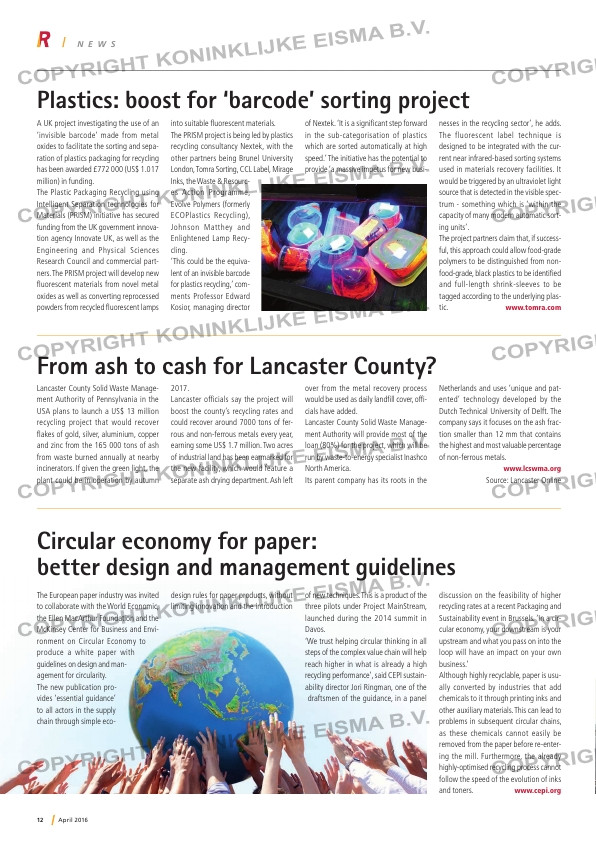Page 12 from: April 2016

12 April 2016
N E W S
From ash to cash for Lancaster County?
Lancaster County Solid Waste Manage-
ment Authority of Pennsylvania in the
USA plans to launch a US$ 13 million
recycling project that would recover
flakes of gold, silver, aluminium, copper
and zinc from the 165 000 tons of ash
from waste burned annually at nearby
incinerators. If given the green light, the
plant could be in operation by autumn
2017.
Lancaster officials say the project will
boost the county’s recycling rates and
could recover around 7000 tons of fer-
rous and non-ferrous metals every year,
earning some US$ 1.7 million. Two acres
of industrial land has been earmarked for
the new facility, which would feature a
separate ash drying department. Ash left
over from the metal recovery process
would be used as daily landfill cover, offi-
cials have added.
Lancaster County Solid Waste Manage-
ment Authority will provide most of the
loan (80%) for the project, which will be
run by waste-to-energy specialist Inashco
North America.
Its parent company has its roots in the
Netherlands and uses ‘unique and pat-
ented’ technology developed by the
Dutch Technical University of Delft. The
company says it focuses on the ash frac-
tion smaller than 12 mm that contains
the highest and most valuable percentage
of non-ferrous metals.
www.lcswma.org
Source: Lancaster Online
Plastics: boost for ‘barcode’ sorting project
A UK project investigating the use of an
‘invisible barcode’ made from metal
oxides to facilitate the sorting and sepa-
ration of plastics packaging for recycling
has been awarded £772 000 (US$ 1.017
million) in funding.
The Plastic Packaging Recycling using
Intelligent Separation technologies for
Materials (PRISM) initiative has secured
funding from the UK government innova-
tion agency Innovate UK, as well as the
Engineering and Physical Sciences
Research Council and commercial part-
ners. The PRISM project will develop new
fluorescent materials from novel metal
oxides as well as converting reprocessed
powders from recycled fluorescent lamps
into suitable fluorescent materials.
The PRISM project is being led by plastics
recycling consultancy Nextek, with the
other partners being Brunel University
London, Tomra Sorting, CCL Label, Mirage
Inks, the Waste & Resourc-
es Action Programme,
Evolve Polymers (formerly
ECOPlastics Recycling),
Johnson Matthey and
Enlightened Lamp Recy-
cling.
‘This could be the equiva-
lent of an invisible barcode
for plastics recycling,’ com-
ments Professor Edward
Kosior, managing director
of Nextek. ‘It is a significant step forward
in the sub-categorisation of plastics
which are sorted automatically at high
speed.’ The initiative has the potential to
provide ‘a massive impetus for new busi-
nesses in the recycling sector’, he adds.
The fluorescent label technique is
designed to be integrated with the cur-
rent near infrared-based sorting systems
used in materials recovery facilities. It
would be triggered by an ultraviolet light
source that is detected in the visible spec-
trum – something which is ‘within the
capacity of many modern automatic sort-
ing units’.
The project partners claim that, if success-
ful, this approach could allow food-grade
polymers to be distinguished from non-
food-grade, black plastics to be identified
and full-length shrink-sleeves to be
tagged according to the underlying plas-
tic. www.tomra.com
Circular economy for paper:
better design and management guidelines
The European paper industry was invited
to collaborate with the World Economic,
the Ellen MacArthur Foundation and the
McKinsey Center for Business and Envi-
ronment on Circular Economy to
produce a white paper with
guidelines on design and man-
agement for circularity.
The new publication pro-
vides ‘essential guidance’
to all actors in the supply
chain through simple eco-
design rules for paper products, without
limiting innovation and the introduction
of new techniques. This is a product of the
three pilots under Project MainStream,
launched during the 2014 summit in
Davos.
‘We trust helping circular thinking in all
steps of the complex value chain will help
reach higher in what is already a high
recycling performance’, said CEPI sustain-
ability director Jori Ringman, one of the
draftsmen of the guidance, in a panel
discussion on the feasibility of higher
recycling rates at a recent Packaging and
Sustainability event in Brussels. ‘In a cir-
cular economy, your downstream is your
upstream and what you pass on into the
loop will have an impact on your own
business.’
Although highly recyclable, paper is usu-
ally converted by industries that add
chemicals to it through printing inks and
other auxiliary materials. This can lead to
problems in subsequent circular chains,
as these chemicals cannot easily be
removed from the paper before re-enter-
ing the mill. Furthermore, the already
highly-optimised recycling process cannot
follow the speed of the evolution of inks
and toners. www.cepi.org



